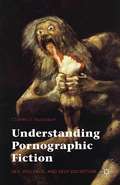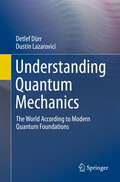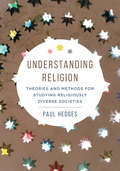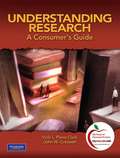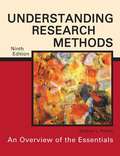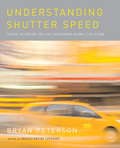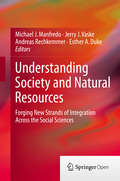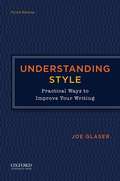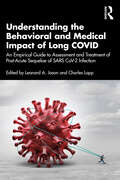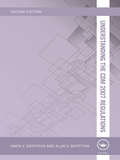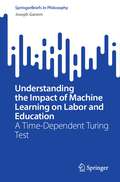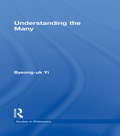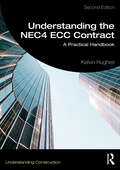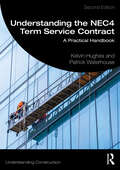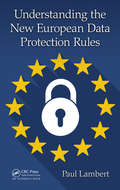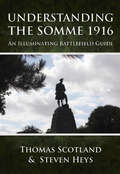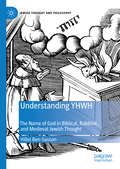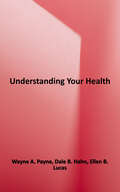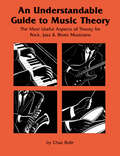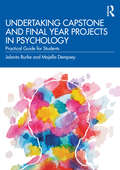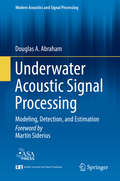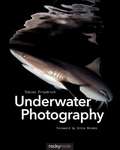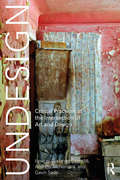- Table View
- List View
Understanding Pornographic Fiction: Sex, Violence, and Self-Deception
by Charles NussbaumThis work defends two main theses. First, modern Western pornographic fiction functions as a self-deceptive vehicle for sexual or blood-lustful arousal; and second, that its emergence owes as much to Puritan Protestantism and its inner- or this-worldly asceticism as does the emergence of modern rationalized capitalism.
Understanding Quantum Mechanics: The World According to Modern Quantum Foundations
by Detlef Dürr Dustin LazaroviciThis book discusses the physical and mathematical foundations of modern quantum mechanics and three realistic quantum theories that John Stuart Bell called "theories without observers" because they do not merely speak about measurements but develop an objective picture of the physical world. These are Bohmian mechanics, the GRW collapse theory, and the Many Worlds theory. The book is ideal to accompany or supplement a lecture course on quantum mechanics, but also suited for self-study, particularly for those who have completed such a course but are left puzzled by the question: "What does the mathematical formalism, which I have so laboriously learned and applied, actually tell us about nature?”
Understanding Religion: Theories and Methods for Studying Religiously Diverse Societies
by Paul Michael HedgesA cutting-edge introduction to contemporary religious studies theory, connecting theory to data. This innovative coursebook introduces students to interdisciplinary theoretical tools for understanding contemporary religiously diverse societies—both Western and non-Western. Using a case-study model, the text considers: A wide and diverse array of contemporary issues, questions, and critical approaches to the study of religion relevant to students and scholarsA variety of theoretical approaches, including decolonial, feminist, hermeneutical, poststructuralist, and phenomenological analysesCurrent debates on whether the term "religion" is meaningfulMany key issues about the study of religion, including the insider-outsider debate, material religion, and lived religionPlural and religiously diverse societies, including the theological ideas of traditions and the political and social questions that arise for those living alongside adherents of other religionsUnderstanding Religion is designed to provide a strong foundation for instructors to explore the ideas presented in each chapter in multiple ways, engage students in meaningful activities in the classroom, and integrate additional material into their lectures. Students will gain the tools to apply specific methods from a variety of disciplines to analyze the social, political, spiritual, and cultural aspects of religions. Its unique pedagogical design means it can be used from undergraduate- to postgraduate-level courses.
Understanding Research: A Consumer's Guide
by Vicki L. Plano Clark John W. CreswellUnderstanding Research: a Consumer's Guide is the first text that places its focus squarely on the needs of the research consumer. This exciting new text helps develop in readers the skills, knowledge and strategies needed to read and interpret research reports and to evaluate the quality of such reports. Users rave about the easy to use and easy to understand format that makes this text perfect for anyone.
Understanding Research Methods: An Overview of the Essentials (Ninth Edition)
by Mildred L. PattenUnderstanding Research Methods provides an overview of basic research methods.The updated text provides a detailed overview of all the important concepts traditionally covered in a research methods class. The numerous examples and large number of exercises help students master the material.
Understanding Shutter Speed
by Bryan PetersonThe first book in the Understanding Photography series,Understanding Exposure, was a runaway best-seller, with more than 250,000 copies sold. Now author Bryan Peterson brings his signature style to another important photography topic: shutter speed. With clear, jargon-free explanations of terms and techniques, plus compelling “before-and-after” photos that pair a mediocre image (created using the wrong shutter speed) with a great image (created using the right shutter speed), this is the definitive practical guide to mastering an often-confusing subject. Topics include freezing and implying motion, panning, zooming, exposure, Bogen Super Clamps, and rendering motion effects with Photoshop, all with helpful guidance for both digital and film formats. Great for beginners and serious amateurs,Understanding Shutter Speedis the definitive handy guide to mastering shutter speed for superb results.
Understanding Society and Natural Resources
by Michael J. Manfredo Jerry J. Vaske Andreas Rechkemmer Esther A. DukeIn this edited volume leading scholars from different disciplinary backgrounds wrestle with social science integration opportunities and challenges. This book explores the growing concern of how best to achieve effective integration of the social science disciplines as a means for furthering natural resource social science and environmental problem solving. The chapters provide an overview of the history, vision, advances, examples and methods that could lead to integration. The quest for integration among the social sciences is not new. Some argue that the social sciences have lagged in their advancements and contributions to society due to their inability to address integration related issues. Integration merits debate for a number of reasons. First, natural resource issues are complex and are affected by multiple proximate driving social factors. Single disciplinary studies focused at one level are unlikely to provide explanations that represent this complexity and are limited in their ability to inform policy recommendations. Complex problems are best explored across disciplines that examine social-ecological phenomenon from different scales. Second, multi-disciplinary initiatives such as those with physical and biological scientists are necessary to understand the scope of the social sciences. Too frequently there is a belief that one social scientist on a multi-disciplinary team provides adequate social science representation. Third, more complete models of human behavior will be achieved through a synthesis of diverse social science perspectives.
Understanding Style: Practical Ways to Improve Your Writing
by Joe GlaserAuthor Joe Glaser explains and illustrates measurable, non-subjective keys to good writing--an approach that yields practical writing techniques and advice rarely found elsewhere. <P><P>An excellent choice for courses in advanced composition, this book also covers more standard topics such as economy, diction, coherence, and variety--along with abundant open-ended exercises drawn from business, history, popular science, and other area.
Understanding the Behavioral and Medical Impact of Long COVID: An Empirical Guide to Assessment and Treatment of Post-Acute Sequelae of SARS CoV-2 Infection
by Leonard A. Jason and Charles LappUnderstanding the Behavioral and Medical Impact of Long COVID serves to expand the research around the illness in order to enable health care researchers and practitioners to address the questions that are imperative to individuals suffering from this condition. Through its multi-faceted approach, the book puts forth a maturation of research and interventions that are theoretically sound, empirically valid, innovative, and creative in the Long COVID area. As a scholarly and scientific compilation of Long COVID symptoms and related disorders, this book offers unparalleled insight into the critical developments across medical areas treating this illness. It helps to fill the space that the pandemic had created for knowledge of the condition, and contributes to the emerging emphasis on translational research blending the social sciences and biological fields. By putting forth the most optimal medical care practices in the treatment of complex Long COVID symptoms, this practical anthology will serve as a guide for practicing clinicians in assessment as well as treatment. It will also benefit researchers aiming to gain more understanding of Long COVID through its discussion around the critical developments in other medical areas treating the condition, and paves the way for the collaboration and future research needed to best support the global effort to mitigate the effects of this illness. This book will be essential reading for academics, practitioners, and researchers. It will appeal to individuals engaging with the fields of medicine, public policy, psychology, and for researchers looking to gain clarity about our current understanding of Long COVID. It will further be of interest to public/government agencies, nonprofit organizations, and the general public wanting to gain more information about these ambiguous and evasive symptoms.
Understanding the CDM 2007 Regulations (Understanding Construction)
by Owen Griffiths Alun GriffithsAlmost 3000 lives have been lost in the UK construction industry over the last twenty-five years, in addition to those seriously injured or made ill. The need to reduce this rate has required tight controls to be introduced throughout the planning and management of construction projects in the UK. The Construction (Design and Management) Regulations 2007 outline the responsibilities and liabilities for the various professionals and agents involved. Straightforward and practical, Understanding the CDM 2007 Regulations demonstrates the rationale behind the regs, covers the duties of the five core duty holders (client, CDM coordinator, designer, principal contractor and contractor), explains the importance of the hazard management process on every project and also sets out the consequences of failing to successfully plan, design and manage for safety. Any client, architect, engineer, CDM co-ordinator, project manager, construction professional, or student will find this a simple but thorough and dependable guide and should value the management toolkit and the numerous practical examples of best practice and guidance on how to use the Approved Code of Practice appropriately. This book shows how to unleash the potential of the regulations and add real value to the industry.
Understanding the Impact of Machine Learning on Labor and Education: A Time-Dependent Turing Test (SpringerBriefs in Philosophy)
by Joseph GanemThis book provides a novel framework for understanding and revising labor markets and education policies in an era of machine learning. It posits that while learning and knowing both require thinking, learning is fundamentally different than knowing because it results in cognitive processes that change over time. Learning, in contrast to knowing, requires time and agency. Therefore, “learning algorithms”—that enable machines to modify their actions based on real-world experiences—are a fundamentally new form of artificial intelligence that have potential to be even more disruptive to labor markets than prior introductions of digital technology. To explore the difference between knowing and learning, Turing’s “Imitation Game,”—that he proposed as a test for machine thinking—is expanded to include time dependence. The arguments presented in the book introduce three novel concepts: (1) Comparative learning advantage: This is a concept analogous to comparative labor advantage but arises from the disparate times required to learn new knowledge bases/skillsets. It is argued that in the future, comparative learning advantages between humans and machines will determine their division of labor. (2) Two dimensions of job performance—expertise and interpersonal: Job tasks can be sorted into two broad categories. Tasks that require expertise have stable endpoints, which makes these tasks inherently repetitive and subject to automation. Tasks that are interpersonal are highly context-dependent and lack stable endpoints, which makes these tasks inherently non-routine. Humans compared to machines have a comparative learning advantage along the interpersonal dimension, which is increasing in value economically. (3) The Learning Game is a time-dependent version of Turing’s “Imitation Game.” It is more than a thought experiment. The “Learning Game” provides a mathematical framework with quantitative criteria for training and assessing comparative learning advantages. The book is highly interdisciplinary—presenting philosophical arguments in economics, artificial intelligence, and education. It also provides data, mathematical analysis, and testable criteria that researchers in these fields will find of practical use. The book calls for a rethinking of how labor markets operate and how the education system should prepare students for future jobs. It concludes with a list of counterintuitive recommendations for future education and labor policies that all stakeholders—employers, employees, educators, students, and political leaders—should heed.
Understanding the Many
by Byeong-uk YiFirst Published in 2002. Routledge is an imprint of Taylor & Francis, an informa company.
Understanding the NEC4 ECC Contract: A Practical Handbook (Understanding Construction)
by Kelvin HughesAs usage of the NEC family of contracts continues to grow worldwide, so does the importance of understanding its clauses and nuances to everyone working in the built environment. This second edition of Understanding the NEC4 ECC Contract uses plain English to lead the reader through the NEC4 Engineering and Construction Contract’s key features. Chapters cover: Contractor’s main responsibilities The use of early warnings Contractor’s design Tendering Quality management Payment Liabilities and insurance Termination Avoiding and resolving disputes and much more.Common problems experienced when using the Engineering and Construction Contract (ECC) are signalled to the reader throughout, and the correct way of reading each clause explained. The way the contract effects procurement processes, dispute resolution, project management and risk management are all addressed in order to direct the user to best practice. This second edition takes into account the updates to the contract released in 2019, 2020 and 2023, and brings the book up to date with the most current practice.Written for construction professionals, by a practicing international construction contract consultant, this handbook is the most straightforward, balanced and practical guide to the NEC4 ECC available. An ideal companion for employers, contractors, project managers, supervisors, engineers, architects, quantity surveyors, subcontractors and anyone else interested in working successfully with the NEC4 ECC.
Understanding the NEC4 ECC Contract: A Practical Handbook (Understanding Construction)
by Kelvin HughesAs usage of the NEC family of contracts continues to grow worldwide, so does the importance of understanding its clauses and nuances to everyone working in the built environment. This second edition of Understanding the NEC4 ECC Contract uses plain English to lead the reader through the NEC4 Engineering and Construction Contract’s key features. Chapters cover: Contractor’s main responsibilities The use of early warnings Contractor’s design Quality management Payment Liabilities and insurance Termination Avoiding and resolving disputes Tendering Common problems experienced when using the Engineering and Construction Contract (ECC) are signalled to the reader throughout, and the correct way of reading each clause explained. The way the contract effects procurement processes, dispute resolution, project management and risk management are all addressed in order to direct the user to best practice. This second edition takes into account the updates to the contract released in 2019, 2020 and 2023, and brings the book up to date with the most current practice.Written for construction professionals, by a practising international construction contract consultant, this handbook is the most straightforward, balanced and practical guide to the NEC4 ECC available. An ideal companion for employers, contractors, project managers, supervisors, engineers, architects, quantity surveyors, subcontractors and anyone else interested in working successfully with the NEC4 ECC.
Understanding the NEC4 Term Service Contract: A Practical Handbook (Understanding Construction)
by Kelvin Hughes Patrick WaterhouseUse of the NEC4 suite of contracts continues to grow and the new edition of Understanding the NEC4 Term Service Contract includes significant additional materials and changes since its original publication immediately after the initial release of the NEC4 contracts. Experienced authors and construction contracts specialists Kelvin Hughes and Patrick Waterhouse have added numerous practical experiences, case studies, lessons learned and guidance notes which were not available at the time of writing the original book.Covering all the recent updates to the contract and written in plain English, Understanding the NEC4 Term Service Contract offers a practical guide to the use and management of the NEC4 Term Service Contract (TSC). The authors describe the full life of a contract, from the initial selection of options and contract formation through to the operations period and ultimately termination and dispute resolution. Although born of the same stable as the NEC4 construction contracts, the TSC is aimed at maintaining infrastructure and differs significantly from its siblings.This is essential reading for anyone working with the contracts and takes the reader through the important provisions including communications, planning, early warnings, compensation events and payments. It is ideal for clients, contractors and their advisors describing how to deploy the contract successfully.
Understanding the New European Data Protection Rules
by Paul LambertCompared to the US, European data and privacy protection rules seem Draconian. The European rules apply to any enterprise doing business in the EU. The new rules are far more stringent than the last set. This book is a quick guide to the directives for companies, particularly US, that have to comply with them. Where US organizations and businesses who collect or receive EU personal data fail to comply with the rule, the bottom line can suffer from very significant official fines and penalties, as well as from users, customers or representative bodies to pursuing litigation. This guide is essential for all US enterprises who directly or indirectly deal with EU personal data.
Understanding the Somme 1916: An Illuminating Battlefield Guide
by Thomas Scotland Steven HeysThis is a guidebook with a difference. It is not a list of memorials and cemeteries. Its aim is to provide the reader with an understanding of the Battle of the Somme. There were some partial successes; there were many disastrous failures. In 17 concise chapters dealing with different areas of the battlefield and various aspects of strategy, this book explains what happened in each location and why. Each chapter is accompanied by color photographs, taken by the authors in the course of many visits to the Somme, which will illustrate, illuminate and allow the reader to understand important points made in the text. It doesn`t matter whether you are in your armchair, on foot, on a bicycle, or in a car, this book will effortlessly transport you to the battlefield and will sweep you round the front line of 1 July 1916. From Montauban in the south, to Serre in the north, it will lead you to the night attack of 14 July and to the first use of tanks on 15 September. It will take you to the Pozières Ridge and to Mouquet Farm, and to the heights above the Ancre. You will visit the famous Sunken Lane near Beaumont Hamel, where the text will transport you in time to stand with men from the 1st Lancashire Fusiliers waiting to go over the top on 1 July 1916. You will look towards Hawthorn Mine Crater and almost feel the earth tremble beneath your feet as though you were there at 07.20 hrs. on 1 July 1916. You will go into Beaumont Hamel with the 51st (Highland) Division and climb up Wagon Road. You will look across to where Frankfurt Trench once was, and where men from the 16th Highland Light Infantry from Glasgow fought a last ditch battle, having become marooned in the trench, in what was the last action to take place before the Somme finally petered out in the mud in late November 1916. With its focus on informing and illuminating the events of 1916 on the Somme, and illustrated throughout by carefully annotated color photographs showing the sites today, this book will prove equally essential to the battlefield visitor or the 'virtual visitor' in their armchair.
Understanding the Universe
by George GreensteinA student-active introduction to astronomy, emphasizing inquiry learning so students will clearly understand our universe and the scientific method. Within-text and end-of-chapter questions check understanding of concepts and require the student to think critically through astronomy-based problems. 'Nature of Science' and 'Detectives on the Case' sections in each chapter encourage students to take on the role of a scientist and so develop an understanding of how scientific progress is made, leading students through a chain of arguments of forming and testing hypotheses, in the context of specific astronomical topics. By focusing on key topics, the student is able to develop a deeper understanding of the core areas of astronomy. Math is used to make intuitive points and kept simple by using a two-track system to first describe the logic of the calculation followed by a more detailed example. Simple illustrations support the text and step students through concepts visually.
Understanding YHWH: The Name of God in Biblical, Rabbinic, and Medieval Jewish Thought (Jewish Thought and Philosophy)
by Hillel Ben-SassonThis book unlocks the Jewish theology of YHWH in three central stages of Jewish thought: the Hebrew bible, rabbinic literature, and medieval philosophy and mysticism. Providing a single conceptual key adapted from the philosophical debate on proper names, the book paints a dynamic picture of YHWH’s meanings over a spectrum of periods and genres, portraying an evolving interaction between two theological motivations: the wish to speak about God and the wish to speak to Him. Through this investigation, the book shows how Jews interpreted God's name in attempt to map the human-God relation, and to determine the measure of possibility for believers to realize a divine presence in their midst, through language.
Understanding Your Health
by Wayne A. Payne Dale B. Hahn Ellen B. LucasThis book offers an exciting and practical approach to the teaching of the traditional content areas of personal health. Its two key themes - the six dimensions of health and the five developmental tasks - help students apply the text's content to their own lives, by improving their decision-making skills. The strength of the Understanding Your Health narrative includes its appeal to both traditional and non-traditional students, particularly the special attention it pays to students over age 25 who have returned to college. <p><p>In addition, among its many health assessment activities, Understanding Your Health includes one of the most comprehensive health assessments found in any personal health textbook - a great tool for establishing a health baseline for students. The companion Online Learning Center (website) offers a wealth of pedagogical and assessment features, including quizzes, Internet activities, downloadable MP3s, and more.
An Understdable Guide to Music Theory: The Most Useful Aspects of Theory for Rock, Jazz, and Blues Musicians
by Chaz BufeThis guide explains the most useful aspects of theory in clear, nontechnical language. Areas covered include scales (major, minor, modal, synthetic), chord formation, chord progression, melody, song forms, useful devices, (ostinato, mirrors, hocket, etc.), and instrumentation. It contains over 100 musical examples.
Undertaking Capstone and Final Year Projects in Psychology: Practical Guide for Students
by Jolanta Burke Majella DempseyUndertaking Capstone and Final Year Projects in Psychology serves a seminal purpose in guiding its readers to create a capstone project. The text employs traditional and emerging methodologies and methods in order to posit an exhaustive approach that the psychology students can adopt to see their project to fruition. The text aims at fortifying the reader’s skills through the structure of its chapters as they begin to work on their capstone or final year project. The chapters collectively explore the varied aspects that are involved in the completion of a final year project, that is, beginning from the inception of the idea to laying the foundation, designing the project, analysing the data, and, finally, presenting the findings. The text guides the reader through each step and provides further guidance on approaching the idea, coming up with the research question, positioning it within the epistemological and ontological context, and constructing the theoretical framework to arrive at the optimal design solutions. The text will be useful for psychology students who are currently completing a capstone or a final year project. It is further aimed at psychology students who will subsequently be working on a project and are looking forward to gaining cognisance regarding the approach and the methodology to be adopted for the same.
Underwater Acoustic Signal Processing: Modeling, Detection, And Estimation (Modern Acoustics and Signal Processing)
by Douglas A. AbrahamThis book provides comprehensive coverage of the detection and processing of signals in underwater acoustics. Background material on active and passive sonar systems, underwater acoustics, and statistical signal processing makes the book a self-contained and valuable resource for graduate students, researchers, and active practitioners alike. <P><P>Signal detection topics span a range of common signal types including signals of known form such as active sonar or communications signals; signals of unknown form, including passive sonar and narrowband signals; and transient signals such as marine mammal vocalizations. This text, along with its companion volume on beamforming, provides a thorough treatment of underwater acoustic signal processing that speaks to its author’s broad experience in the field.
Underwater Photography
by Tobias FriedrichUnderwater photography is a fascinating pursuit for those who aspire to capture the magical world found within our oceans and bring it to the surface. In this book, award-winning photographer Tobias Friedrich teaches us how to create stunning underwater images, covering everything from the equipment needed, to creating powerful compositions, to processing the final image. He uses case studies to show how his own images were created, and provides detailed explanations for specific techniques that can be applied to your very next dive.The text is supported by images from some of the most beautiful diving areas on Earth. Also included are countless tips and tricks for the beginner and intermediate photographer.Topics include:Choosing the right equipmentComposing your imagesWide-angle photographyMacro photographyImage editingCase studiesDiagrams of shooting positionsAn added bonus is the 22-page Guest Gallery featuring images by some of today's most recognized names in underwater photography, including Ernie Brooks, Alex Mustard, Richard Salas, Imran Ahmad, and Eric Cheng.The abundance of breathtaking underwater images contained in this book is sure to inspire you to plan your next dive.Foreword by Ernie Brooks.
Undesign: Critical Practices at the Intersection of Art and Design
by Gretchen Coombs Andrew McNamara Gavin SadeUndesign brings together leading artists, designers and theorists working at the intersection of art and design. The text focuses on design practices, and conceptual approaches, which challenge the traditional notion that design should emphasise its utility over aesthetic or other non-functional considerations. This publication brings to light emerging practices that consider the social, political and aesthetic potential of "undesigning" our complex designed world. In documenting these new developments, the book highlights the overlaps with science, engineering, biotechnology and hacktivism, which operate at the intersection of art and design.
